Introduction Imagine a glistening, utterly smooth vein of milky quartz 395 miles long and 50 miles wide, set amid dense, mountainous forests: Baikal in winter. “A primordial deep lake of diamantine clarity,” as Peter Matthiessen wrote in Baikal: Sacred Lake of Siberia, it is, among other things, the world’s oldest lake and the deepest, at 5750 feet at its lowest, with an additional four miles of sediment above the bedrock. The great Baikal Rift—by far the deepest depression on the planet—is seven times as deep as the Grand Canyon. It is also the most voluminous, holding an astounding 20 percent of the world’s fresh water—if all the world’s rivers were to drain into an empty Baikal, it would take a year to fill. And, to cap off the superlatives, it’s unquestionably the most interesting, with its crystal clear water and 100,000 freshwater seals, called nerpa, that inhabit its northern waters, in the middle of a vast continent! Baikal is surely the most hugely beautiful lake in the solar system. “Baikal,” writes Yevgeny Yevtushenko, “is the blue heart of Siberia, pulsing amidst the green ocean of the taiga.” On this journey we’ll explore the lake in its bracingly cold solitude, visiting tiny wooden hamlets set by the shore, staying in boutique hotels and private homes, ice fishing, troika riding and perhaps even some dog-sledding, and of course walking joyously on the frozen surface of the world’s deepest and perhaps most ardently loved lake. As Baikal’s laureate, Valentin Rasputin, has written, “Baikal itself, alive, majestic . . . not comparable to anything and not repeated anywhere, is aware of its own primordial place and its own life force.” This tour is offered by world famous Geographic Expeditions, US ( (a pioneer of travel to remote and challenging destinations since 1982 – www.geoex.com) ,that’s why accompanying you will be a life force of his own, the great environmentalist and practical visionary Huey Johnson, a great, zesty companion, perhaps the leading American proponent of green plans, a guy who founded the Resource Renewal Institute, the Trust for Public Land, the Grand Canyon Trust, the Environmental Liaison Center in Nairobi, Defense of Place, and the Aldo Leopold Society and who is the recipient of the President’s Award for Sustainable Development and the UN’s top environmental honor, the Sasakawa Prize. Despite all those laurels, Huey is a simpatico guy, a great fellow to wander with at the world’s greatest lake. The Itinerary Description Days 1 & 2 - Wednesday & Thursday, March 16 & 17
Depart from your hometown, arriving in Moscow in the evening of Day 2 where you will be met by our leaders and transferred as a group to the hotel. (Geographic Expeditions can make your airline reservations for you—please call Air Department of Geographocal Expeditions for a quote). Now is a fascinating time to visit Russia. Change has been flooding the country and Moscow is as dynamic as any modern city. The nerve center of this massive land is the Kremlin, sitting “like the sovereign crown on the brow of a stern ruler,” as Lermontov wrote in 1834. Just walking in Red Square is a riveting experience—vast, crowded, and almost mountainous in its grandeur. On one side are the cliffs of the Kremlin with Lenin’s ominous Mausoleum at the foot, on the other side the cavernous G.U.M. department store, the former USSR’s largest, and on the eastern entrance to the square, the iconic St. Basil’s Cathedral. “In looking at this impossible church,” wrote Theophile Gautier, “one is tempted to ask if it is not a whimsical will-o’-the wisp, an edifice formed of clouds fantastically colored by the sun, which the movement of the air will presently cause to change in form, or vanish into nothingness.” St. Basil’s was deemed so ethereal that, according to legend, Ivan the Terrible had its architects blinded so they could never again build anything so wondrous. Standard Rooms, Hotel Metropol (no meals) Day 3 After a late breakfast, we check out of our hotel and take a guided tour of the city’s highlight, the Kremlin, walking through 600 years of Russian and Soviet history. We visit its three cathedrals: the exquisite 15th century Assumption Cathedral, completed in 1479 by the Bolognese architect Aristotle Fioravanti, the Annunciation Cathedral built only a decade earlier, and Archangel Cathedral, coronation site of the Tsars and burial site for several of them. These cathedrals serve as a vivid and rich reminder of old Russia’s mystic devotion. The Assumption Cathedral is a synthesis of traditional Russian architectural styles, though its classical proportions mark it as a work of the Italian Renaissance; it was the first instance of foreign architecture in the country. The Kremlin complex also contains gardens, bell towers, palaces and churches, as well as the Palace of Congresses, built in 1961. We also visit the extraordinary Armory and the Diamond Exhibition where the jewels owned and worn by Russian royalty over the years are on display. In the late afternoon we drive to the airport for our overnight flight to Irkutsk. Overnight in flight (B,L,in-flight snack) Day 4 - Saturday, March 19 We arrive early in the morning in Irkutsk, the capital of Irkutsk Oblast (territory) and one of the most important cities of Siberia. After breakfast and a morning rest at our hotel, we spend the afternoon touring this halfway point between Moscow and the easternmost point of Siberia. Although the Irkutsk Oblast is but a small segment of Siberia, it is as large as Switzerland, France, Holland, Belgium, Austria, and Denmark combined. Siberia alone boasts six million square miles and fantastically varied topography including mountains, endless steppes, Arctic tundra, great stands of virgin forests, volcanoes, high plateaus, vast rivers, and lakes filled with game fish. Four large rivers—the Lena, Kitoy, Irkut, and Angara—keep most of the Irkutsk Oblast lush with forests and link many villages and cities.
After lunch, we have a special opportunity to visit the Baikal Environmental Wave Center and have a private meeting with its co-chair Marina Rikhvanova, the 2008 Goldman Environmental prize winner for Asia. Marina Rikhvanova and the organization she helped found have successfully fought against industrial pollution at Lake Baikal, halting construction of a petroleum pipeline along the shores of the lake. The organization is currently trying to prevent the storage of radioactive nuclear material at a nearby facility. Learn from Marina about current environmental threats to Baikal and discuss the Wave’s efforts to combat them. Marina Rekhvanova will join us for our welcome dinner tonight is at a Russian restaurant specializing in local fare, followed by a Russian folklore performance. Victoria Hotel (B,L,D) Day 5 After breakfast, we check out of the hotel for departure by coach to the Listvyanka settlement, located on Lake Baikal at the mouth of the Angara River (the lake’s only outlet). Our drive takes us along the Irkutsk-Baikal road, which was constructed almost 50 years ago in preparation for President Eisenhower’s visit. The President was invited to visit the lake because of his Siberian gold merchant ancestry. After the shooting of an American U-2 spy plane, however, the President’s visit was canceled. En route we stop to explore the Museum of Wooden Architecture, located half-way between Listvyanka and Irkutsk. Illustrating the lifestyles of 16th to 19th century Russians, this museum displays various aspects of village life, the interiors of a Russian fort and 15th century Our first glimpse of Lake Baikal occurs near Shaman Rock before we reach Listvyanka. We’ll stop here to listen to the legend of “Father Baikal and his disobedient daughter Angara” recounted by our guide before continuing on to the charming little village of Listvyanka, an old-style Siberian village famous for its trade history. In the 18th century its ferry took merchants across the lake on the journey to Mongolia, China, and the Russian Far East. A cozy Russian hotel awaits us in Listvyanka; after check-in we enjoy the first of many excellently prepared Russian country feasts. Lunch is followed by a visit to the Baikal Limnological Museum, which features one-of-a-kind exhibits on the flora and fauna of Lake Baikal and an aquarium where several Baikal freshwater seals live. Let’s also visit the old wooden church of St. Nicholas, where you can burn a candle as a blessing for your safe and successful journey. If time allows, the next stop is the Baikal Solar Station, where we meet local scientists and discuss their conservation efforts. Baikal Terema Hotel or similar (B,L,D) Day 6 - Monday, March 21 Baikal lies along a tectonic break surrounded by mountains and rocky, tree-covered cliffs. Its banks rise to 1600 feet above sea level, and the mountains surrounding it boast over 9000 feet. Lake Baikal’s water is crystal clear—a white sheet thrown into it can be clearly seen at a depth of 120 feet. Scientists still disagree on how the omul, a white fish of the salmon family, as well as the sea cows and seals (all typically salt water sea life), reached Baikal from the sea. We spend the day enjoying the exceptional natural setting of the region and partaking in some of Russia’s traditional outdoor pastimes including dog-sledding and a troika ride. A traditional Russian banya, or sauna, serves as the perfect end to this active day, once we’ve sampled a variety of traditional Siberian cuisine including smoked and salted omul. Baikal Terema Hotel or similar (B,L,D) Day 7 - Tuesday, March 22
From Boshie Koty we carry on to Peschanaya (“Sandy”) Bay, oft-referred to as the Siberian Riviera due to its extended Riverside Estate Lodge (B,L,D) Day 8 - Wednesday, March 23 After breakfast we have a leisurely morning to enjoy our surroundings and the opportunity to ice skate on the river if we wish. After lunch, it’s on to the Khuzhir settlement on Olkhon Island, the largest and only permanently inhabited island on the lake. En route we stop to see the famous Tsagan Zaba White Marble Cliffs and observe the petroglyphs that date back more than 2500 years with scenes from the lives of shamanistic believers. The famous Russian anthropologist Okladnikov called these petroglyphs “the Pearls of ancient art.” There’s plenty of time for an up-close inspection.
Upon arrival in Khuzhir, we check in to the guesthouse, our home for the next 3 days. After dinner, our local guides—passionate ice-fisherman—introduce some ice-fishing secrets on how to catch Baikal’s famed fish: grayling, perch and the endemic omul. Nikita Bencharov homestead (B,L,D) Day 9 Breakfast is followed by a morning of ice fishing , during which we set up near our “kamchatka”, or traditional omul group fishing area, where tents and huts perch on the ice over long-established fishing spots. We learn about the local methods of attracting fish by the use of shrimp bait called “burmash”. Fishermen drop large amounts of the burmash in order to entice the omul to feed under their ice-holes. Watch—and participate if you choose—in the ice-hole drilling with promises of local rewards for the fastest driller. Our fishing ground will be not far from the shore and a bit less accessible to the less-dedicated fishermen. The entire fishing shall be a kind of “Cool Fisherman” competition (the more fish you have caught regardless of its size and weight the better). Before lunch the fishing shall be stopped and the result of the competition summed up, and winners will be rewarded.. Nikita Bencharov homestead (B,L,D)
Day 10 - Friday, March 25
Afterwards we board our ACVs to go back on the ice, this time in search of the famed freshwater seals of Baikal, the nerpa, the only freshwater seals in the world. With luck, we can find them in their natural habitat. How the freshwater seal came to be in Lake Baikal is still a mystery; the lake is hundreds of miles from the nearest ocean. Now for the day’s highlight: a visit on the ice to the “Baikal Polar Spot” or to the Great Pole of Baikal located above the deepest point of the lake (at 5435 feet). Here we are met by Bashiila, the President of the Oriel Shamanistic Fund and a local hereditary shaman. Known locally as “Uncle Vasya”, Bashiila demonstrates a traditional ritualistic ceremony devoted to the deities of Lake Baikal and honoring the health of the earth. Nikita Bencharov homestead (B,L,D) Day 11 This morning we say goodbye to the island and set out for Ust-Ordat. Several sightseeing stops en route include a visit to an “ovoo” (or “obo”), another sacred site of worship for local shamanist believers. In Ust-Orda, activities include a visit to the Buryat Ethnography Museum followed by a Buryat folklore performance. Buryats are a native Siberian people whose history and culture closely relate to that of their southern Mongolian neighbors. We also explore a Buryat shamanistic center—the traditional wooden yurt home of the shaman¬—and sample some of the Buryat national cuisine including salamt, arza, and tarasun moonshine. Bashiila will speak to us about the philosophy, religion and culture of the local Buryat people and their traditional conservation practices, describe the shaman practice and altar, and perform a short ritual in honor of travelers and local spirits. We continue back to Irkutsk to check in to our hotel and enjoy our toast-filled farewell dinner.
Victoria Hotel (B,L,D) Day 12 - Sunday, March 27 The morning’s breakfast is followed by transfer to the airport and a flight back to the capital. Upon arrival in Moscow, we drive directly to lunch for our final Russian meal before checking in to the hotel and enjoying the rest of the day at our leisure for some last-minute gift shopping, explorations or rest before tomorrow’s early morning departure. Standard Rooms, Hotel Metropol (B,L) Day 13 - Monday, March 28 Early this morning transfer as a group to the airport for the return flight to the USA. Geographic Expeditions’ land arrangements conclude here. (B)
A Note on the Trip Grade, Fitness Level & Accommodations This trip is graded rigorous touring with limited facilities. This itinerary takes us to one of the most remote parts of Siberia in Russia. We feel part of the joy of travel in this area is its special quality of seclusion; however, participants should be aware that amenities outside of Moscow are rustic or sparse at best. Please take note of the following limitations: Be prepared to encounter odd plumbing, mediocre meals, a lack of hot water, an occasional power outage, lack of public toilets, and varying—though pleasant—service in the Irkutsk/Baikal region. An adventurous spirit, open mind and sense of humor will more than compensate for the potential inconveniences of traveling in rewarding but challenging regions such as this. NOTE 2: During the dates of March,27-28,2013, there’s Siberia’s only Ice Golf Tournament “Baikal Prize Open” held on Lake Baikal. Those tour participants who want to see it or even take part Geographic Expeditions can offer an 3 days extension trip.
|
|
World time
--:-- :--
--.--.--
Our TOURS by CategoryOur Special ServicesSearch
Send an e-mail:
|
language: ENG / RUS
© All rights reserved by Absolute Siberia LTD.
|
Weather in Irkutsk
Our NEWS 25.02 2015 15.05 2013 |




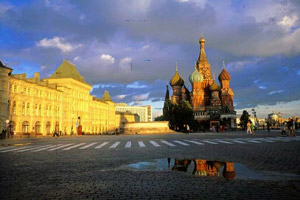
 - Friday, March 18
- Friday, March 18 Our first excursion is to the old part of town, which still has a collection of tumbledown wooden houses, and to Znamenskaya monastery where many 19th century exiles from Moscow and St. Petersburg lie buried in the churchyard. Znamenskaya is also noted for its historical grave of the so-called “Russian Columbus,” Grigory Shelekhov, who was an early Russian explorer of Alaska, and the graves of the Decembrists revolutionaries who were named to Siberia after an ill-fated attempt in 1825 to overthrow the Russian tsar.
Our first excursion is to the old part of town, which still has a collection of tumbledown wooden houses, and to Znamenskaya monastery where many 19th century exiles from Moscow and St. Petersburg lie buried in the churchyard. Znamenskaya is also noted for its historical grave of the so-called “Russian Columbus,” Grigory Shelekhov, who was an early Russian explorer of Alaska, and the graves of the Decembrists revolutionaries who were named to Siberia after an ill-fated attempt in 1825 to overthrow the Russian tsar.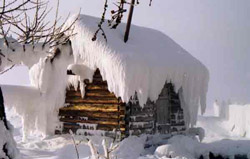 - Sunday, March 20
- Sunday, March 20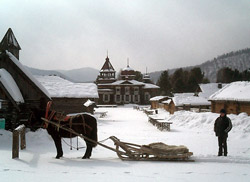 watchtower, information about the Buryat and Evenk people, and a Shaman yurt.
watchtower, information about the Buryat and Evenk people, and a Shaman yurt.
 This morning we board the “Khivus”, our air cushioned amphibious vessel (ACV), to begin sightseeing on Baikal. We travel across the thick frozen lake ice to our first stop, Bolshie Koty, and visit the local biological research station of Irkutsk University. A local Baikal specialist named Lyubov Izmestyeva, whose family of scientists has done research on Baikal for three generations, teaches us about life in and around the lake. The data this single family has collected may be the world’s most extensive historical record of the area.
This morning we board the “Khivus”, our air cushioned amphibious vessel (ACV), to begin sightseeing on Baikal. We travel across the thick frozen lake ice to our first stop, Bolshie Koty, and visit the local biological research station of Irkutsk University. A local Baikal specialist named Lyubov Izmestyeva, whose family of scientists has done research on Baikal for three generations, teaches us about life in and around the lake. The data this single family has collected may be the world’s most extensive historical record of the area.  periods of sunshine. Upon arrival in Peschanaya Bay we enjoy a guided walk to take in the panoramic views of the taiga forest and one of the lake’s natural wonders, the so-called “wandering trees.” The trees’ roots are exposed by winds which blow away the sand so that the trees stand high above the beach—in some cases almost 6 feet above. Their position shifts slightly each year as a result of the blowing winds and sandy soil, allowing the nickname Wandering Trees. We will also have lunch on the ice and if weather conditions are optimal we may stop here for some ice fishing lessons.
periods of sunshine. Upon arrival in Peschanaya Bay we enjoy a guided walk to take in the panoramic views of the taiga forest and one of the lake’s natural wonders, the so-called “wandering trees.” The trees’ roots are exposed by winds which blow away the sand so that the trees stand high above the beach—in some cases almost 6 feet above. Their position shifts slightly each year as a result of the blowing winds and sandy soil, allowing the nickname Wandering Trees. We will also have lunch on the ice and if weather conditions are optimal we may stop here for some ice fishing lessons.  said:” Rock Art in Tsagaan – Zaba Bay is a unique phenomenon among the others incised drawings of Siberia. Petroglyphs in Sagaan – Zaba are genuine pearls of ancient art and that of Siberian peoples. There is nothing matching them anywhere else from the Urals to the Pacific ocean”. Unfortunately, the future of this historical evidence is endangered. First, the monks of Posolsky monastery bewitching the demon power of Tsagaan Zaba inscribed two crosses on the ancient drawings. Then a number of rock drawings were damaged by later signs (1898, 1913, 1943). And only by some chance fluke was the rock saved from destruction when in its immediate vicinity marble was mined by detonation. And later the sign “A.V. Pervushin, 1966” destroyed several valuable drawings. That A.V. Pervushin, perhaps, was unable to realize what he really had done, but there’s no excuse for him - by his own hand he added his name into the history of vulgarity and vandalism…
said:” Rock Art in Tsagaan – Zaba Bay is a unique phenomenon among the others incised drawings of Siberia. Petroglyphs in Sagaan – Zaba are genuine pearls of ancient art and that of Siberian peoples. There is nothing matching them anywhere else from the Urals to the Pacific ocean”. Unfortunately, the future of this historical evidence is endangered. First, the monks of Posolsky monastery bewitching the demon power of Tsagaan Zaba inscribed two crosses on the ancient drawings. Then a number of rock drawings were damaged by later signs (1898, 1913, 1943). And only by some chance fluke was the rock saved from destruction when in its immediate vicinity marble was mined by detonation. And later the sign “A.V. Pervushin, 1966” destroyed several valuable drawings. That A.V. Pervushin, perhaps, was unable to realize what he really had done, but there’s no excuse for him - by his own hand he added his name into the history of vulgarity and vandalism…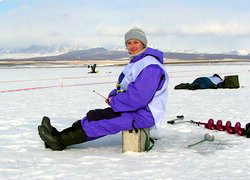 Our next destination is Olkhon Island. Divided lengthways, one half of this narrow island is covered in forest and the other in steppe, a landscape that defines much of Siberia. En route we wind through the “Small Sea”, part of Lake Baikal sandwiched between the mainland shore and the island’s eastern shore. Time permitting, we may be able to visit the small island of Ogoy—site of the lake’s only Buddhist stupa. At more than 32 feet high, the stupa holds 2.5 tons of Buddhist mantras and 1,543 pounds of holy Buddhist books that were brought from Nepal. The Ogoy stupa recently became a site for Buddhist pilgrimages.
Our next destination is Olkhon Island. Divided lengthways, one half of this narrow island is covered in forest and the other in steppe, a landscape that defines much of Siberia. En route we wind through the “Small Sea”, part of Lake Baikal sandwiched between the mainland shore and the island’s eastern shore. Time permitting, we may be able to visit the small island of Ogoy—site of the lake’s only Buddhist stupa. At more than 32 feet high, the stupa holds 2.5 tons of Buddhist mantras and 1,543 pounds of holy Buddhist books that were brought from Nepal. The Ogoy stupa recently became a site for Buddhist pilgrimages.  - Thursday, March 24
- Thursday, March 24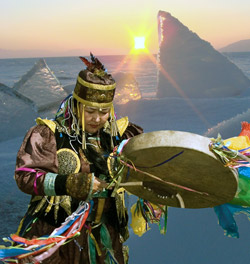 Today we set out for an excursion around the island, first driving to the northernmost point, the Cape of Khoboy (translation: “fang”). The Cape is located at the widest point of Lake Baikal and offers the best views of the Eastern and Western shores. For the local shamanist believers, the site is a sacred spot.
Today we set out for an excursion around the island, first driving to the northernmost point, the Cape of Khoboy (translation: “fang”). The Cape is located at the widest point of Lake Baikal and offers the best views of the Eastern and Western shores. For the local shamanist believers, the site is a sacred spot.  - Saturday, March 26
- Saturday, March 26





